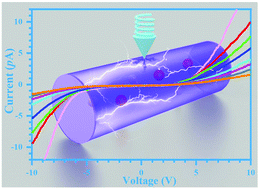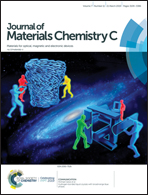The N and P co-doping-induced giant negative piezoresistance behaviors of SiC nanowires
Abstract
The third-generation semiconductor silicon carbide (SiC) is identified as one of the vitally important candidate materials to serve as a functional unit that performs stably and reliably under harsh working conditions, with respect to its excellent piezoresistive effects and robust physical/chemical characteristics. In the current work, we put forward the fabrication of SiC nanowires with co-doped N and P elements, which were fabricated via the pyrolysis of a polymeric material. The as-grown nanowires have a typical diameter of ∼260 nm with a 1![[1 with combining macron]](https://www.rsc.org/images/entities/char_0031_0304.gif) 0 surface. The measured transverse piezoresistance coefficient π[1
0 surface. The measured transverse piezoresistance coefficient π[1![[1 with combining macron]](https://www.rsc.org/images/entities/char_0031_0304.gif) 0] of the established SiC nanowires increased from 5.07 to −146.30 × 10−11 Pa−1 as the loading forces varied from 24.95 to 130.51 nN. Meanwhile, the corresponding gauge factor (GF) was calculated up to ca. −877.79, which is higher than the values for all SiC nanostructures ever reported. The mechanism concerning the giant negative piezoresistance behavior of SiC nanowire is proposed. The current exploration may pave a new avenue for the development of highly sensitive and robust pressure sensors that could survive under harsh working conditions.
0] of the established SiC nanowires increased from 5.07 to −146.30 × 10−11 Pa−1 as the loading forces varied from 24.95 to 130.51 nN. Meanwhile, the corresponding gauge factor (GF) was calculated up to ca. −877.79, which is higher than the values for all SiC nanostructures ever reported. The mechanism concerning the giant negative piezoresistance behavior of SiC nanowire is proposed. The current exploration may pave a new avenue for the development of highly sensitive and robust pressure sensors that could survive under harsh working conditions.



 Please wait while we load your content...
Please wait while we load your content...